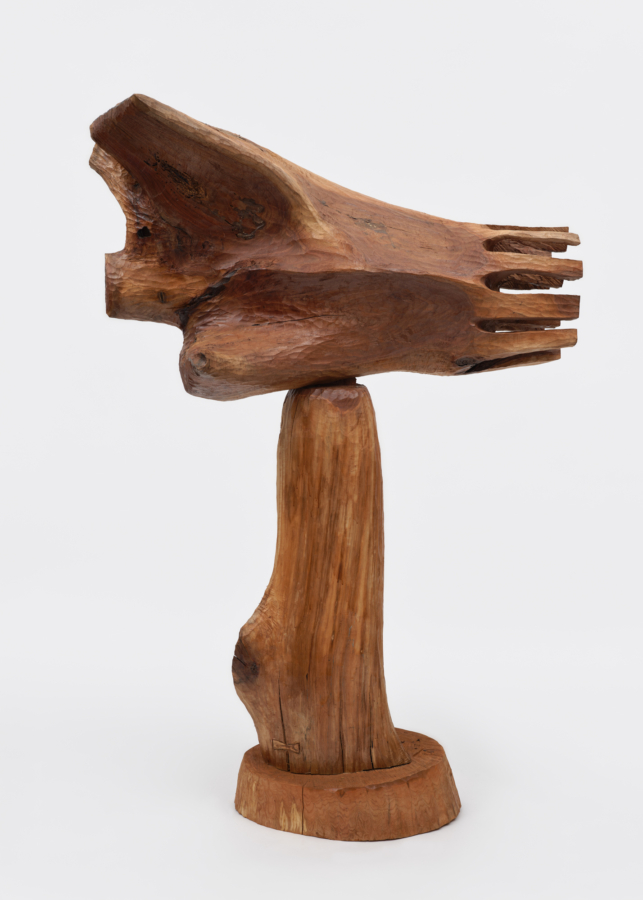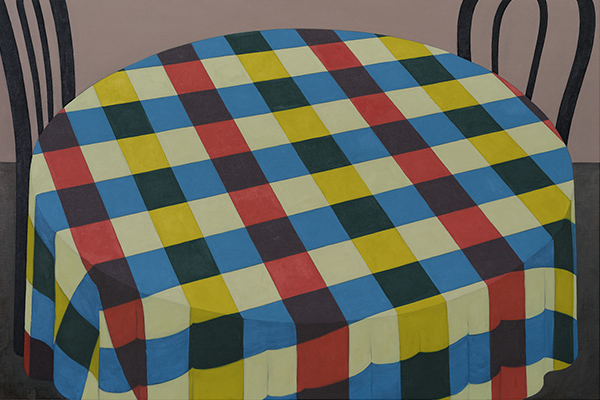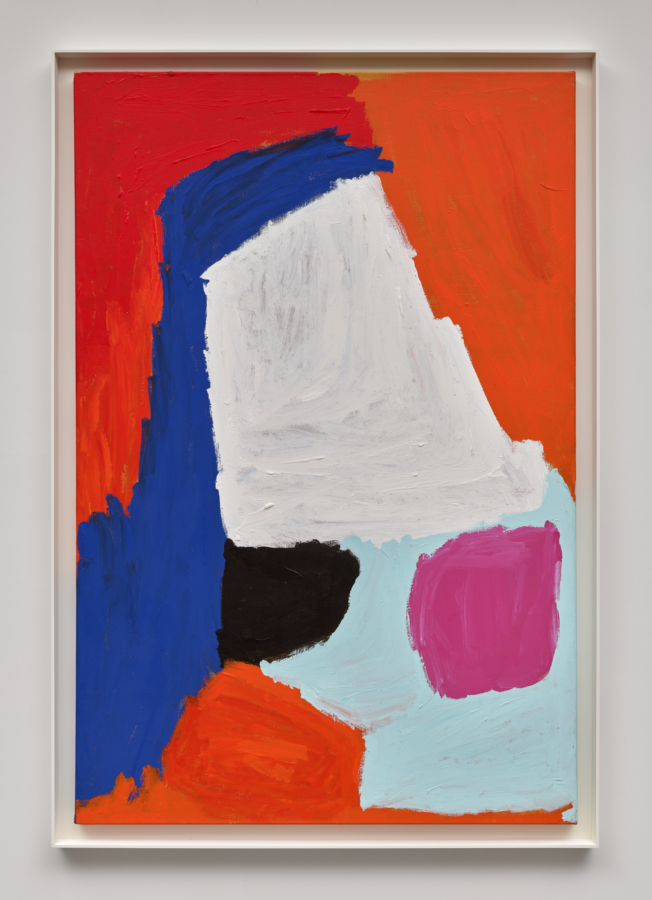2021
Maja Ruznic: In The Sliver of The Sun, text by Nicole Dial-Kay, Hariz Halilovich, Annie Godfrey Larmon, Harwood Museum of Art, 2021.
In painting, the touch changes the thought and goes elsewhere; the thought alters and returns to the touch.
—Bracha L. Ettinger
The world is gone. I must carry you.
—Paul Celan
When she paints, Maja Ruznic often listens to sevdah, traditional folk music from her native Bosnia and Herzegovina set in somber, minor modes. Sevdah reflects the complex heterogeneity of Bosnia’s history. From its Arabic origins, the word means black bile, and from its Ottoman Turkish roots, it evokes unrequited love. These twinned, disparate expressions result in a particular melancholy that holds longing and ambivalence together. “When I make work, I always touch that space internally,” Ruznic explains. “Painting has become a way for me to touch what I couldn’t reach.” The sought object, the unreachable form, only becomes apparent to Ruznic as she bodies it forth.
Tactility arrives for Ruznic through a slow process of accumulating materials and looking. Her compositional strategy draws her in a rhythmic push and pull with the margins of the canvas, such that no passage is neglected. Layering stains of Gamsol-thinned pigment and scumbling and sanding paint, she develops surfaces from which compositions of figures are coaxed out, as if alchemically—as if they were inherent to the combination of material, duration, embodiment, and memory that occasioned them. Starchy washes, oily lacuna, tremulous delineations—these traces are bodily, abysmal, cosmic. Her irresolute fits and starts of accretive marks cool into tempered pools; her brushwork isn’t tentative, but intentionally open-ended.
In muted, earthen hues, we see familiar arrangements of figures, postures that suggest canons: the odalisque, the Pietà, the Adoration. In The Return (2020), for example, umbered lines and blushed stains cohere as the three Graces. Ruznic’s figures are shapely, wispy, and arcuate; they emerge from and recede into their surrounds. The fluid contours recall those of the Symbolists and Nabis, who likewise summoned Biblical and Greek archetypes to express subjective experience. In Ruznic’s canvases, there is something of the articulate line work and murky palette of Pierre Puvis de Chavannes; the kaleidoscopic, encompassing space of Édouard Vuillard; the anomalous, lachrymose heads of Odilon Redon, as well as his “shudder of the colored surface by tone over tone.” Indeed, there is the labile naturalism of Edvard Munch. But where these fin-de-siècle painters sought escape from reality—from the empiricist, imperialist views that then commanded European society—into the imaginary, Ruznic seeks communion with deeper, even sub-perceptual, forms of empiricism: epigenetics, somatic knowledge, inherited trauma.
Ruznic paints archetypes as they are filtered through her body, which summons the compositions and narratives with its particular priorities and obfuscations. In this way, she joins collective and subjective memories, not producing entanglements, but revealing those that already exist. Ruznic works from a place that accepts the palimpsestic compositeness of subjectivity, its frayed bounds.
The paintings and psychoanalytic theory of Bracha L. Ettinger have offered a generative language to Ruznic’s practice. Circumventing the phallocentric tenets of modernism, Ettinger pursues an aesthetic that transcends the opposition of abstraction and empathy and, rather, expresses a humanism grounded in the woman as subject. Ettinger, who has written of the remedial possibilities of painting, approaches the practice as a “withnessing,” wherein alliances are formed with the unknown. Her theory of the matrixial borderspace suggests a differently conceived organization of self and Other—a logic based on the ethical and embodied connection between mother and child:
“From the side of the woman-mother as subject—a woman in the unicity of her individuality—we must recognize a triple trauma of maternity and prematernity: the traumatic proximity to the Other during pregnancy, the traumatic regression to a similar archaic sharing (of the mother as infant with her own m/Other) and the traumatic separation from the non-I during birth-giving … The womb-like compassion is a key to access the Other in its nude vulnerability. I see this nude vulnerability as feminine-maternal openness to fragilizing self-relinquishment.”
Ettinger writes of this trans-subjective relation as an “ab-presence.”
Ab-presences resound in Ruznic’s paintings, in the flickering translucencies and spectral figures they depict, but also in their very materiality. Ruznic uses the same canister of Gamsol for a body of paintings, beginning each canvas with stains of the thinner, which becomes progressively murkier as she paints. In this way, the DNA of the original painting is inherited by each subsequent work. The hue of the muddied pigment is a gray-inflected blue, and it deepens as Ruznic works through a series of paintings. The color is recognizable as haze, as the blue of distance. This blue is a stand-in for desire. It offers to these works an atmosphere of impossibility, of the scattered light that obscures the place where one is not.
An event at the heart of Ruznic’s work has everything to do with distance. In 1992, as a child, she fled the war in Bosnia with her mother and lived for several years in refugee camps throughout Europe before settling in San Francisco. The artist remembers not being aware of the war at the time; her mother, a single parent, protected her from the outside world. But one moment from the year of the onset of the war holds particular intensity: in May, she escaped with her grandparents to Croatia before her mother could join them, and, in her mother’s absence, she lost the ability to perceive time. Then, late one morning, the shape of her mother’s hair emerging from fog, the smell and weight of her. Ruznic describes her paintings as a recreation of these sensations, that memory, of reuniting. She also describes painting as touching a wound.
When Ruznic returns to Bosnia, the presence of trauma is tangible; she describes its inscription on surfaces: “The skin of people looks thicker. Some are missing limbs; the buildings have scars from shells.” She registers the ways in which the experience differs among generations in the diaspora as well; her mother wants to forget the war, “as if it’s the honorable thing to do.” With her paintings, Ruznic returns to her experience and channels it—we see these palimpsestic surfaces—but she has control over what she includes and omits. As if in co-emergence with the figures she paints, Ruznic transcends the wound space by touching it on the canvas.
The paintings on view at the Harwood are coincidentally framed by the nine months of Ruznic’s pregnancy. As she confronted her changing relationship to her body, the cleaving and humming of subjectivity, and the surrender to different kinds of durations, the themes already present in her work took new shape. In each of three paintings titled The Painters and Their Daughter, for example, three silhouetted figures are differently in relation to each other—in collusion, in celebration, in concern, maybe. Each bleeds into the next and into their surround. The third figure doesn’t appear as an infant or child; it might be a specter of Ruznic’s postpartum depression—“becoming a mother sent me to meet my dark sister,” she explained. The pragmatics of her condition likewise impacted the work on a material level, as she had to forego the toxic cobalts and cadmiums; she traded in Gamsol for safflower oil. In the early months of her motherhood, Ruznic’s mark-making was subject to a new economy of time, and her gestures became more urgent, her decisions raw and quick.
These paintings are by turns ecstatic and taciturn, as frenetic and languid as the year that saw their arrival. Touch and its impossibility entered the work in unforeseen ways, as the pandemic ushered in the weaponization and stigmatization of contact and created new conceptions of distance. The title of the exhibition, In the Sliver of the Sun, came to the artist while she watched her cat migrate throughout the day to where the light streamed into the living room, following a trace of warmth, the touch of something greater, a connective tissue.



